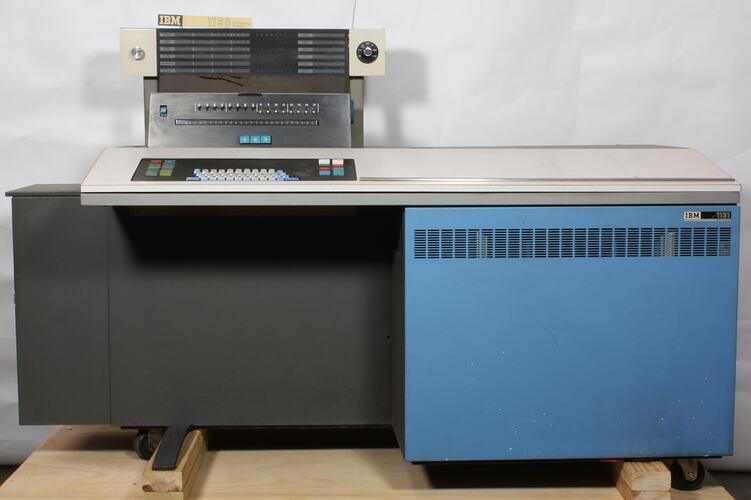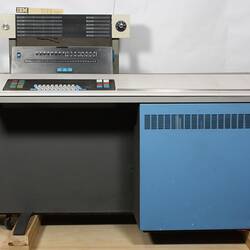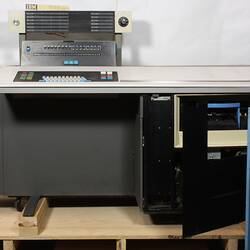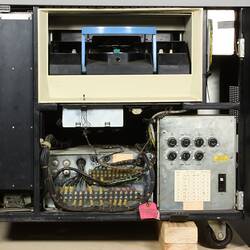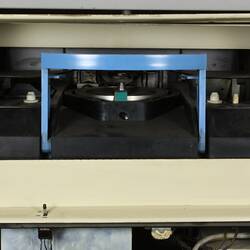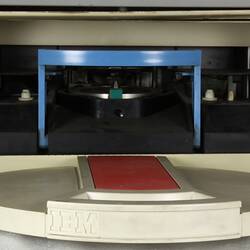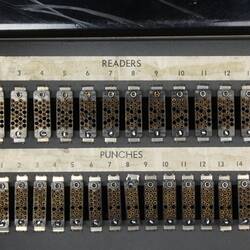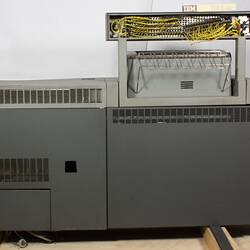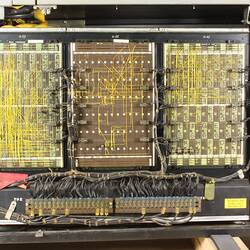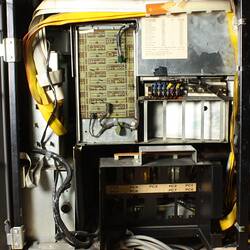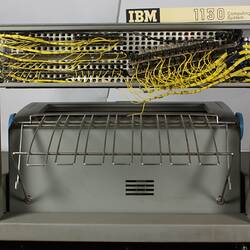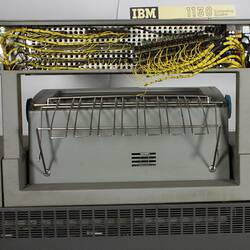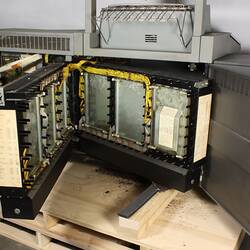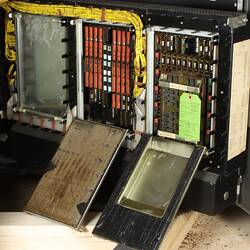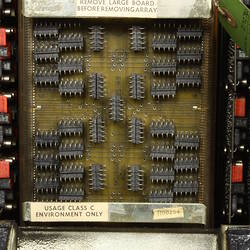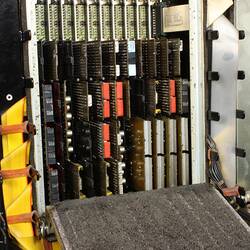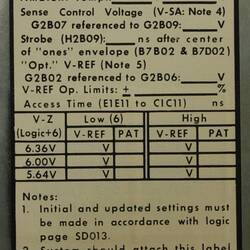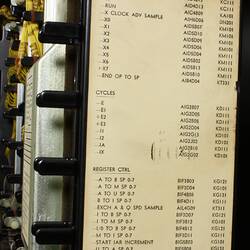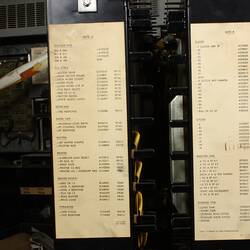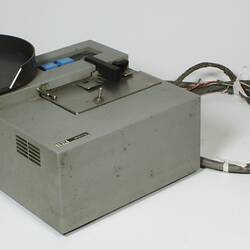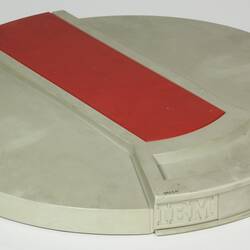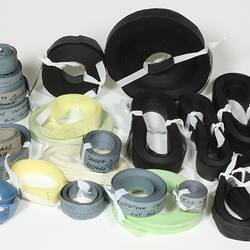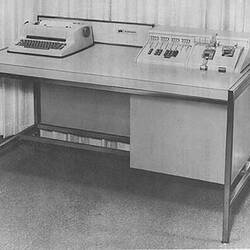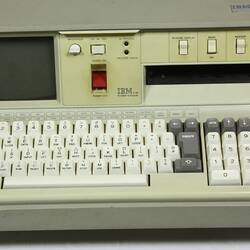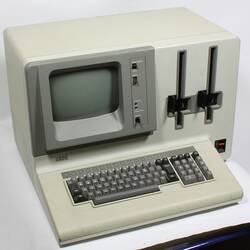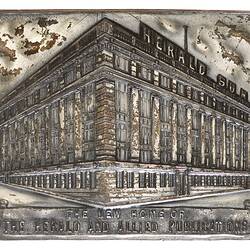Summary
IBM Model 1130 computer entry for typesetting system, used at Herald and Weekly Times from 1968 onwards, complete with magnetic disc memory system, keyboard/printer/control panel on desk and spare 'hard discs' (each 512 kilobytes (= 1/2 megabyte), plus extensive documentation.
The IBM 1130 Computer System entered production in the United States in 1965. The machine was aimed at the engineering and educational markets and gave many users their first experience of 'personal computing'. The 1130 incorporated removable disk storage, permitting users to store their own programs and data, independent of other users. The 1130 system was based on an IBM 1131 Central Processing Unit (CPU) which was combined with a console containing a keyboard, a printer and control switches and displays. Other units available included additional disk storage units, card punches and readers, and line printers.
The IBM 1130 uses SLT hybrid devices. Solid Logic Technology (SLT) was IBM's method for packaging electronic circuitry introduced in 1964 with the IBM System/360 series and related machines. IBM chose to design custom hybrid circuits using discrete, flip chip-mounted, glass-encapsulated transistors and diodes, with silk screened resistors on a ceramic substrate. The circuits were either encapsulated in plastic or covered with a metal lid. Several of these were then mounted on a small multi-layer printed circuit board to make an SLT module.
Physical Description
The system includes a CPU desk unit with keyboard, single data station, paper tape punch, twelve magnetic disk cartridges and 106 paper tape rolls containing programs and/or data, 16 blank paper tape rolls, equipment drawings, diagrams, print-outs, program listing and various documents and components. (1) CPU Desk Unit with Keyboard: Metal cabinet, finished variously in blue and grey, houses IBM 1131 Central Processing Unit. Console resting on top of cabinet extends to left to provide kneehole for operator. Console contains QWERTY keyboard between two sets of eight control push buttons. Printer located behind keyboard. Fifteen toggle switches on front panel of printer. Behind and above printer is rectangular box containing twelve digital displays and two control knobs. * Single Data Station: Beige and blue desk unit with keyboard, two diskette units, and display unit. The display unit is viewed through a periscope, which was refitted in July 2012; it is registered as a separate part: ST 043746.2. The rear panel can be removed; it has a holder containing a plastic pouch and a field engineering manual with blue plastic covers and ring binders. The manual includes an envelope containing three 8 inch floppydisks. The pouch contains a machine incident log and four miscellaneous items. * Paper Tape Punch: Grey metal box with crackle finish with controls on top, coiled cable at rear terminating with two plug-ins. On top rear, circular plastic container for reel of paper tape. Removable box contains chards from paper tape. * One of the magnetic disk cartridges: Circular beige plastic case encasing metal disk. Case exterior is shaped for use in computer disk drive. Metal disk is exposed on one side. On the other side, the central component of case is red.
Significance
A large desktop console, this machine is an example of the transition from floor mounted computers with work stations (minicomputers, for example, the IBM System 3) to microcomputers with the standard configuration - box, screen, keyboard and, later, mouse.
This machine exemplifies how computers were first introduced into the Australian newspaper industry, in particular the cumbersome efforts made to "automate" existing practices. The words were typed in from journalists' copy, a magnetic memory generated, and a paper type ribbon developed which was sent to the hot metal type setter. If any mistakes were made, then the whole paper tape had to be redone.
More Information
-
Collecting Areas
-
Acquisition Information
Donation from IBM Australia Pty Ltd, 21 Mar 1996
-
Manufacturer
International Business Machines (IBM), United States of America, 1968
IBM were Manufacturer & Designer -
User
Herald & Weekly Times, Melbourne, Greater Melbourne, Victoria, Australia, circa 1968-1996
-
Inscriptions
(1) CPU Desk System with Keyboard: On front of 1131 Processor cabinet: 'IBM 1131 / Processor' On front and back of sign above printer: 'IBM 1130 Computing / System'. * Single Data Station: Desk unit: (various labels for swirches etc.) / (modified QWERTY keyboard) Exterior of plastic pouch: (text) / 13-5-74 Cover of Log: (IBM logo) AUSTRALIA LTD. / DP CUSTOMER ENGINEERING / MACHINE INCIDENT LOG / CUSTOMER (handwritten)A.M.W.U. / TYPE (handwritten)3741 SERIAL (handwritten)51957 / STATUS (handwritten)1 / DATE INSTALLED (handwritten)10 . 9 . 1976 Inside log: (7 entries dated) 19 11 77 / 30 11 77 / 18 8 78 / 23 / 8 78 / 30 5 80 / 14 11 80 / 9 11(incomplete) Manual front cover: Field Engineering / (IBM logo) Manual cover spine: (IBM logo) Field engineering Serial Number (handwritten)51957 * Paper Tape Punch: Label on top: IBM/Telle-Processing/1055 PAPER TAPE PUNCH On bottom: (embossed)743902/(emblem)/13409 * One of the magnetic disk cartridges: Case Label: IBM CE CARTRIDGE/SERIAL NUMBER/104092/MADE IN U. S. A. Case Label: PROPERTY OF IBM/ASSET NO. T.11.6218 Rim of disk: (embossed)IBM
-
Classification
-
Category
-
Discipline
-
Type of item
-
Overall Dimensions
1650 mm (Length), 750 mm (Width), 1070 mm (Height)
Dimensions apply to IBM 1131 Central Processing Unit plus console including keyboard, printer and displays.
-
References
IBM Archives accessed 10 Jan 2012: [Link 1] IBM 1130 accessed 2 July 2012: [Link 2] Herald Sun printing department 2 July 2012: [Link 3] Text of press release accessed 2 July 2012: [Link 4] ******************************************************* Extract from IBM 1130 - initial announcement (IBM Data Processing Division press release distributed on February 11, 1965): For ease of use by many individuals, an advanced storage technique is available with the 1130 computer. Data and instructions for computer processing are recorded on a magnetic disk similar in appearance to a phonograph record. Disks are protected by a plastic cartridge. Each IBM 2315 disk cartridge can hold the equivalent of more than one million characters of information. The cartridge enables an engineer, for example, to store information about his own work on his own disk. When he wishes to use the computer, he simply slides the disk with its plastic jacket into a slot on the 1130 console. Information from the disk is transferred into the 1130's high-speed core memory for processing. The computer has a memory capacity equivalent to more than 16,000 characters of information. *********************************************************
-
Keywords
